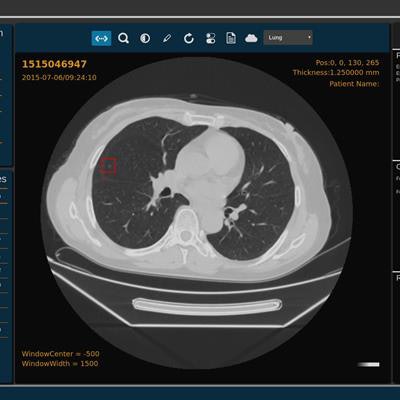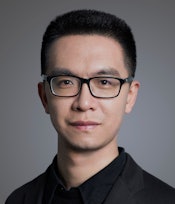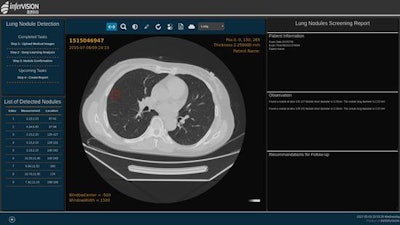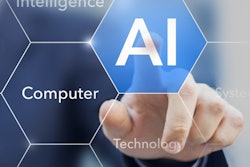
An artificial intelligence (AI) start-up in China is seeking to use deep learning to help address the country's severe shortage of radiologists. The firm believes its algorithms will make radiologists more efficient by helping them read images faster and focus more attention on abnormal exams.
The company, called Infervision, has developed deep-learning algorithms that can perform traditional computer-aided detection (CAD) functions such as determining if a chest x-ray or CT is abnormal, as well as highlight abnormalities for the radiologist. The firm is also working to train models that can classify and characterize abnormalities.
 Chen Kuan, CEO of Infervision.
Chen Kuan, CEO of Infervision.The algorithms are meant to improve the efficiency of radiologists by eliminating many of their highly repetitive tasks, said CEO Chen Kuan. For example, radiologists in China spend as much as 90% of their time performing tedious tasks such as searching for small lung nodules.
"In the future, we can let AI replace this part of the work of the radiologist," he said.
Radiologists can then use this extra time to focus on more challenging diagnostic tasks, Kuan said. He will discuss Infervision's progress in a presentation today at this week's NVIDIA GPU Technology Conference (GTC) in San Jose, CA.
Potential in radiology
Infervision has its roots in machine-learning work conducted by Kuan when he was a doctoral student at the University of Chicago in 2014. On a trip home to China, Kuan met a radiologist who told him about the potential for deep learning to improve the diagnostic process in radiology. Further discussions with other radiologists at other hospitals convinced Kuan of the demand for this technology, and he decided to suspend his participation in the doctoral program and return to China full-time to found Infervision.
While deep learning wasn't very well-known in China at the time, physicians were well-acquainted with traditional CAD software, he said.
"In the past, traditional CAD has not lived up to their expectations," Kuan said. "Some experts were quite disillusioned with vision intelligence in general."
Infervision worked initially with one hospital to develop a deep-learning model that was able to predict -- with up to 90% accuracy -- whether a chest x-ray was normal or abnormal. Based on that performance, the company was able to build partnerships with other institutions, Kuan said. This provided access to even more imaging data to train the deep-learning algorithms, and it also helped the company receive venture capital funding. Infervision recently raised $7.2 million during a Series A funding round led by venture capital firm Sequoia Capital.
"All of our products and all of our models are improving by the day, because we have more data and the models are training themselves," Kuan said.
Infervision's platform makes use of a combination of recurrent neural networks and convolutional neural networks and can currently be used to perform two functions. In the first, the firm's models can determine if a chest x-ray is normal or abnormal, as well as point out the abnormal areas on the exam to the radiologist. Infervision's platform can also be used to find nodules and fibrosis on chest CT exams, he said.
"We can highlight [these findings] for the radiologist, and they can use the information to assist them in their next stage of diagnosis," Kuan said.
 Infervision has developed a deep-learning model that can be used to identify lung nodules on chest CT studies. Image courtesy of Infervision.
Infervision has developed a deep-learning model that can be used to identify lung nodules on chest CT studies. Image courtesy of Infervision.Training
The models have been trained initially using images stored on hospital PACS and the radiology report stored on their institution's RIS. This allows the model to learn how to distinguish between normal and abnormal images.
The next phase -- detecting the pathologic area on the study -- requires images that have been annotated with the findings in order for the software to learn. It's difficult, however, to build a dataset that includes enough images with annotation for the software to learn, Kuan said. As a result, the company has hired radiologists to annotate images in their spare time.
While the Infervision platform currently offers functionality comparable to that of traditional CAD software, Kuan believes the deep-learning platform will provide significant improvements in accuracy over its CAD predecessors. As evidence of the software's performance, Kuan described how researchers at a Chinese hospital found the software's sensitivity to be equivalent to that of radiologists for detecting nodules larger than 6 mm. It was higher, however, for nodules 3 mm to 6 mm in size, and much higher for nodules smaller than 3 mm.
"The smaller the nodules, the more sensitive the machine is," Kuan said.
Importantly, the software also had much higher sensitivity than radiologists for ground-glass nodules, he said.
The Infervision platform is currently awaiting approval from the China Food and Drug Administration (CFDA).
Aiding diagnosis
The company is also working to train models that can tackle the next phase of a diagnosis: classifying the abnormalities to determine, for example, the likelihood of malignancy. This process is challenging because it requires access to pathological data to provide a confirmed diagnosis, Kuan said.
"Not a lot of patients have that [pathological data], even in some of the biggest hospitals in China," he said. "For example, if you have a big cancer in your lung, you might not operate on it at all. You might go to chemotherapy directly, or maybe you will not go into any treatment at all or go to another hospital."
As a result, the company has not yet gathered enough data to adequately train a model that could be deployed to classify abnormalities on a clinical case.
"We are hoping to release this type of product by the end of this year," Kuan said.
Workflow
Infervision's technology is currently being used in two ways by its partner hospitals. Some radiologists prefer to access the software before they view the images, while others use the software after they've performed their initial review, Kuan said.
"We are currently observing which [approach] will take charge," he said.
Infervision has partnered with GE Healthcare and other PACS vendors in China. With some partners, a button is added to the PACS software that enables users to access the Infervision AI algorithms as an overlay to the original image, according to the company. GE and Infervision are also working on different business opportunities in China, Kuan said. In addition, Infervision is continuing to work to integrate its platform with other PACS providers in the Chinese market.
The firm has also formed separate partnerships with NVIDIA, Cisco Systems, and Intel, allowing these companies to bundle the Infervision platform along with their hardware during sales to Chinese hospitals.
Future work
Once it gains CFDA approval, Infervision will also seek to provide its AI algorithms to hospitals and to private imaging centers, which have increasingly been opened across China.
In addition to developing AI models that can classify abnormalities, Infervision is also developing models for other body areas, such as the brain and stomach. The company hopes to roll those out by the end of 2017 or early 2018, Kuan said. While the company is focusing primarily on China at the moment, it is also looking for global partners to extend its reach to other countries.
In the meantime, Infervision is working to educate radiologists on deep learning and how it can be used to improve their workflow, Kuan said.



















